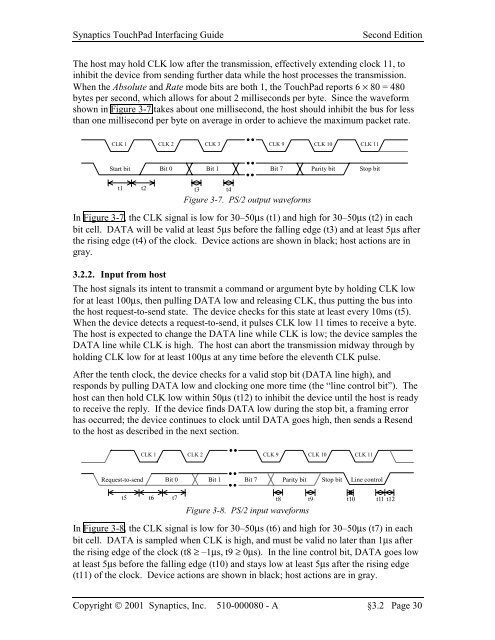Synaptics TouchPad Interfacing Guide
Synaptics TouchPad Interfacing Guide
Synaptics TouchPad Interfacing Guide
You also want an ePaper? Increase the reach of your titles
YUMPU automatically turns print PDFs into web optimized ePapers that Google loves.
<strong>Synaptics</strong> <strong>TouchPad</strong> <strong>Interfacing</strong> <strong>Guide</strong> Second Edition<br />
The host may hold CLK low after the transmission, effectively extending clock 11, to<br />
inhibit the device from sending further data while the host processes the transmission.<br />
When the Absolute and Rate mode bits are both 1, the <strong>TouchPad</strong> reports 6 × 80 = 480<br />
bytes per second, which allows for about 2 milliseconds per byte. Since the waveform<br />
shown in Figure 3-7 takes about one millisecond, the host should inhibit the bus for less<br />
than one millisecond per byte on average in order to achieve the maximum packet rate.<br />
CLK 1<br />
CLK 2<br />
CLK 3<br />
Start bit Bit 0<br />
Bit 1 Bit 7 Parity bit Stop bit<br />
t1 t2<br />
t3 t4<br />
Figure 3-7. PS/2 output waveforms<br />
In Figure 3-7, the CLK signal is low for 30–50µs (t1) and high for 30–50µs (t2) in each<br />
bit cell. DATA will be valid at least 5µs before the falling edge (t3) and at least 5µs after<br />
the rising edge (t4) of the clock. Device actions are shown in black; host actions are in<br />
gray.<br />
3.2.2. Input from host<br />
The host signals its intent to transmit a command or argument byte by holding CLK low<br />
for at least 100µs, then pulling DATA low and releasing CLK, thus putting the bus into<br />
the host request-to-send state. The device checks for this state at least every 10ms (t5).<br />
When the device detects a request-to-send, it pulses CLK low 11 times to receive a byte.<br />
The host is expected to change the DATA line while CLK is low; the device samples the<br />
DATA line while CLK is high. The host can abort the transmission midway through by<br />
holding CLK low for at least 100µs at any time before the eleventh CLK pulse.<br />
After the tenth clock, the device checks for a valid stop bit (DATA line high), and<br />
responds by pulling DATA low and clocking one more time (the “line control bit”). The<br />
host can then hold CLK low within 50µs (t12) to inhibit the device until the host is ready<br />
to receive the reply. If the device finds DATA low during the stop bit, a framing error<br />
has occurred; the device continues to clock until DATA goes high, then sends a Resend<br />
to the host as described in the next section.<br />
CLK 1<br />
CLK 2<br />
Figure 3-8. PS/2 input waveforms<br />
CLK 10<br />
CLK 11<br />
In Figure 3-8, the CLK signal is low for 30–50µs (t6) and high for 30–50µs (t7) in each<br />
bit cell. DATA is sampled when CLK is high, and must be valid no later than 1µs after<br />
the rising edge of the clock (t8 ≥ –1µs, t9 ≥ 0µs). In the line control bit, DATA goes low<br />
at least 5µs before the falling edge (t10) and stays low at least 5µs after the rising edge<br />
(t11) of the clock. Device actions are shown in black; host actions are in gray.<br />
Copyright © 2001 <strong>Synaptics</strong>, Inc. 510-000080 - A §3.2 Page 30<br />
CLK 9<br />
CLK 9<br />
CLK 10<br />
CLK 11<br />
Request-to-send Bit 0 Bit 1 Bit 7 Parity bit Stop bit Line control<br />
t5 t6 t7<br />
t8 t9<br />
t10 t11 t12


